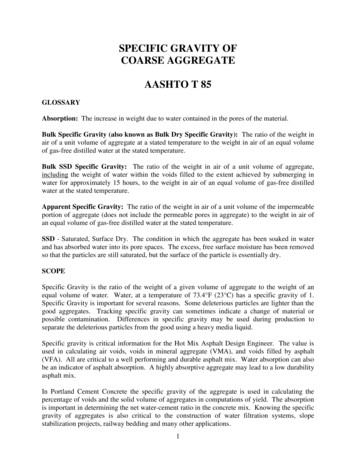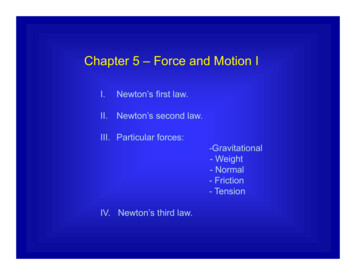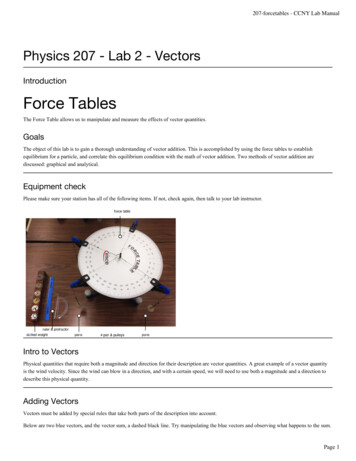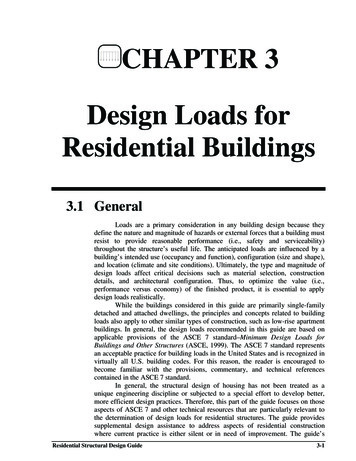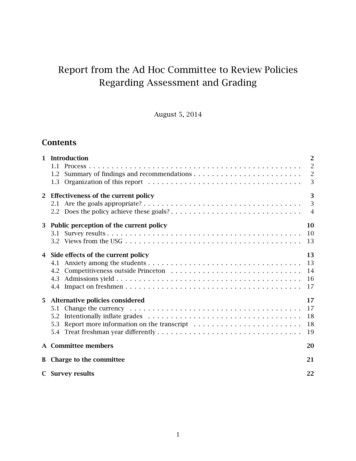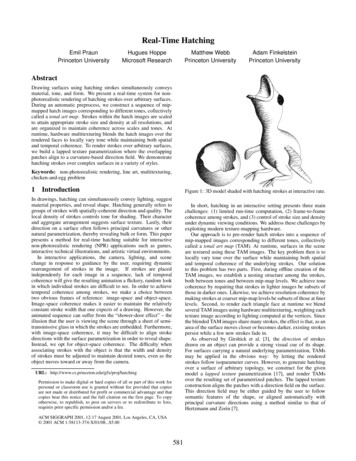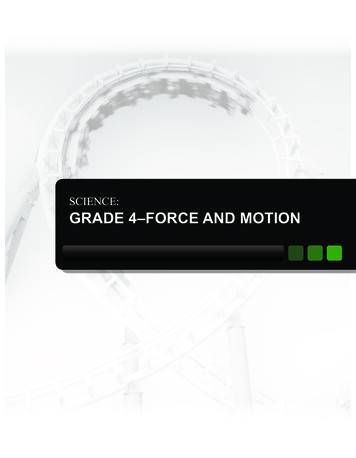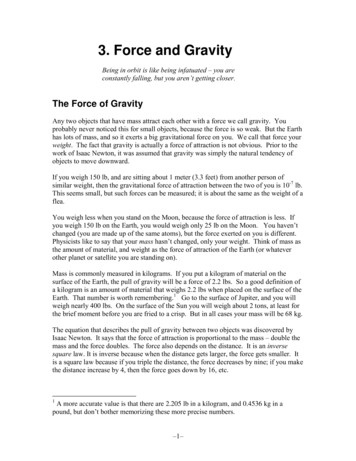
Transcription
3. Force and GravityBeing in orbit is like being infatuated – you areconstantly falling, but you aren’t getting closer.The Force of GravityAny two objects that have mass attract each other with a force we call gravity. Youprobably never noticed this for small objects, because the force is so weak. But the Earthhas lots of mass, and so it exerts a big gravitational force on you. We call that force yourweight. The fact that gravity is actually a force of attraction is not obvious. Prior to thework of Isaac Newton, it was assumed that gravity was simply the natural tendency ofobjects to move downward.If you weigh 150 lb, and are sitting about 1 meter (3.3 feet) from another person ofsimilar weight, then the gravitational force of attraction between the two of you is 10-7 lb.This seems small, but such forces can be measured; it is about the same as the weight of aflea.You weigh less when you stand on the Moon, because the force of attraction is less. Ifyou weigh 150 lb on the Earth, you would weigh only 25 lb on the Moon. You haven’tchanged (you are made up of the same atoms), but the force exerted on you is different.Physicists like to say that your mass hasn’t changed, only your weight. Think of mass asthe amount of material, and weight as the force of attraction of the Earth (or whateverother planet or satellite you are standing on).Mass is commonly measured in kilograms. If you put a kilogram of material on thesurface of the Earth, the pull of gravity will be a force of 2.2 lbs. So a good definition ofa kilogram is an amount of material that weighs 2.2 lbs when placed on the surface of theEarth. That number is worth remembering.1 Go to the surface of Jupiter, and you willweigh nearly 400 lbs. On the surface of the Sun you will weigh about 2 tons, at least forthe brief moment before you are fried to a crisp. But in all cases your mass will be 68 kg.The equation that describes the pull of gravity between two objects was discovered byIsaac Newton. It says that the force of attraction is proportional to the mass – double themass and the force doubles. The force also depends on the distance. It is an inversesquare law. It is inverse because when the distance gets larger, the force gets smaller. Itis a square law because if you triple the distance, the force decreases by nine; if you makethe distance increase by 4, then the force goes down by 16, etc.1A more accurate value is that there are 2.205 lb in a kilogram, and 0.4536 kg in apound, but don’t bother memorizing these more precise numbers.–1–
The Equation of Newton’s Law of Gravity“Newton’s Law of Gravity” gives the gravity force between two objects with masses mand M separated by distance r:F GmMr2G is called the Gravitational Constant, and has the value 6.67 10 11 N m 2kg 2 (N is forNewton, the physicists’ unit of force) or 1.5 10 11 lb m 2kg 2 . Let’s go back to the example given in the text: two 150 lb people separated by 1 meter.150lb these into the formula givesThe mass of each person is 68kg . Puttinglb2.2 kg F 1.5 10 11 lb m 2 kg 2 (68kg) 2 10 7 lb .2(1m) Newton’s Law of Gravity actually gives the force only between two small objects. If oneof the objects is a sphere (such as the Earth) then it turns out that you can still use theformula, but you must use the distance to the center of the sphere as the value for r. Asan example, let’s put in numbers for a 1 kg object sitting on the surface of the Earth.Then the force of attraction is given by the gravity equation with m 1 kg, M the massof the Earth 6 1024 kg, and r radius of the Earth (that’s the distance to the center ofthe sphere). This distance is r 6371 km 6 106 meters. Without plugging in thenumbers, can you guess what the answer will turn out to be? Guess, and then check thisfootnote2 to see if you guessed correctly.Suppose you weigh 150 lbs on the Earth. Then your mass is150lb 68kg . What willlb2.2 kgyou weigh on the Moon? We can calculate that by using Newton’s Law of Gravity, andputting in the M the mass of the Moon 7.3 1022 kg, r the radius of the moon 1.7 106 meters. The answer is F 25 lb. That means you will weigh 25 lb. on thesurface of the Moon.Newton’s Third LawHere is something that might surprise you: if you weigh 150 lb, not only is the Earthattracting you with a force of 150 lb, but you are attracting the Earth with a force of 150lb too. This is an example of something called “Newton’s third law” – if an object exertsa force on you, then you exert the same force back on it.2The answer is 2.2 lb. Of course, that is the weight of a 1 kg object.Also, 1 newton 4 ½ pounds, so we could express the answer as about ½ newton.–2–
But if you are so small, how can you exert such a large force on the Earth? The answer isthat, even though you are small, your mass exerts a force on every piece of the Earth,simultaneously. When you add all those forces together, the sum is 150 lb. So you arepulling up on the Earth exactly as much as the Earth is pulling down on you.Think of it in the following way. If you push on some else’s hand, they feel your force.But you feel the force too. You push on them; they push back on you. The same thingworks with gravity. The Earth pulls on you; you pull on the Earth.The “weightless astronaut” paradoxImagine an astronaut in orbit in a capsule 200 km (125 miles) above the surface of theEarth. What does he weigh? Because he is further away from the mass of the Earth, theforce is slightly lower. From Newton’s Law of Gravity, we can calculate that he isweighs 142 lb, i.e. he is 8 lb lighter.Calculation:We can calculate the astronaut’s weight by using Newton’s Law of Gravity. Assume hismass is 68 kg. (That is his mass if he weighs 150 lb when standing on the surface.) Thedistance between him and the surface of the Earth is (6371 200) km (his altitude theEarth’s radius) 6.57 x106 meters. Plug that into the formula for the gravitational forceand you get F 142 lbs. On Earth he weighed 150 lbs. The astronaut weighs 8 lb lessbecause he is further from the Earth. 200 km seems like a lot, but added to the radius ofthe Earth, it made only a 3% change in r, and that’s why the weight didn’t change bymuch.But wait a minute – aren’t orbiting astronauts weightless? Movies show them insidespace ships floating around. How can they do that if they weigh almost as much as theydo when they are on the surface of the Earth?To understand the answer to this paradox, we have to think about what it means to beweightless. Suppose you are in an elevator, and the cable suddenly breaks. The elevatorand you fall together. During those few seconds before you crash into the ground, youwill feel weightless. You will float around inside the elevator. You will feel no force onyour feet, and your shoulders will not feel the weight of your head. (Your head falls withyour chest, at the same rate, so the muscles in your neck need exert no force to keep thehead above the chest.) In those brief seconds you have the same “weightless” experienceas the astronauts. All the time, of course, the Earth is pulling you rapidly towards it.3You have weight, but you feel weightless. A movie made of you inside the elevatorwould show you floating around, apparently without weight, while you and the elevator3There are rides at some amusement parks that allow you to fall for long distances andexperience weightlessness, at least for a small number of seconds. We’ll calculate howmany seconds in a later section.–3–
fell together. You would look just like the astronauts floating around in the SpaceStation.Now imagine that instead of falling, you and the elevator are shot together out of a gun,and fly 100 miles before hitting the ground. During that trip, you will again feelweightless. That’s because you are in motion along with the elevator. You and it fly inthe same arc.4 Your head and chest are both moving in that arc together; there is no forcebetween them and your neck muscles can be completely relaxed. Your head will seem tohave no weight. Prior to the space program, potential astronauts were flown in airplanesfollowing such arcs in order to see how they responded to the sensation of weightlessness– and to get them used to it.When you and the elevator are moving together under the force of gravity (either fallingor shot in an arc) there seems to be no gravity. From that alone, you might think youwere far out in space, far away from the gravity of any planet, star, or moon. From insidethe elevator, you can’t tell the difference.Now imagine that at the top of a very tall tower (200 km high) is a large gun, pointinghorizontally. We shoot the elevator and you horizontally. If we picked a low velocity(e.g. 2 km/sec) you and the elevator would curve towards the Earth, and you would crashinto it, as in path A in the figure below. But instead we pick a high velocity: 8 km/sec.You and the elevator are shot from the gun, and you curve towards the Earth, but becauseof your high velocity, you miss the edge of the Earth, as in path B. You keep on curvingdownward, but you never hit. You are in orbit. The force of gravity makes the path of theelevator – let’s call it a space capsule now – curve downwards. But if that curvaturematches the curvature of the Earth, then it misses the surface, and stays at a constantheight.5Figure: Capsule shot into space from a tower4Your path is a geometric curve known as a parabola.5If your velocity is not exactly horizontal, or if your velocity is a little low or high, thenthe orbit will not be a circle but an ellipse.–4–
This may seem preposterous, but it is reasonable to think of an astronaut in orbit aroundthe Earth as being in a state of perpetual falling. That’s why he feels weightless.You can think of the Moon as doing the same thing. It is attracted to the Earth bygravity, but it has high sideways motion. Even though it is falling towards the Earth, isalways misses.The Velocity for Low Earth Orbit (LEO)To stay in a circular orbit just a few hundred miles above the surface, the velocity of thesatellite must be about 8 km per second, which is about 18,000 miles per hour. (Theactual value depends slightly on the altitude; we’ll derive this number from a calculationlater in this chapter.) At this velocity, the satellite orbits the 24,000 miles circumferenceof the Earth in about 1.5 hours.If the astronaut wants to land, he does not point his rockets downward and fire his rocketsaway from the Earth; he fires his rockets towards the direction he is headed – in theforward direction! That slows down the satellite, so it is no longer going fast enough tomiss the edge of the Earth. Gravity brings the satellite back to Earth. If the satellitemoves faster than 8 km per second, it leaves the circular orbit and heads out into space.At about 11 km per second it will have sufficient velocity to reach the Moon and beyond.This velocity is called the escape velocity. We’ll discuss this concept further later in thischapter.Analogy with a Rock and SlingThere is another way to think about Earth satellites. Forget gravity for a moment.Imagine that you have a rock tied at the end of a string, and you are spinning it in a circleabove your head. The string provides the force that keeps the rock from flying away, thatkeeps the rock in circular motion. If the string breaks, the rock flies off in a straight line.Gravity does the same thing for an Earth satellite: it provides the force that keeps thesatellite in a circular orbit.An old weapon called the “sling” is based on this principle. A rock is held by a leatherstrap, and spun in circles over the head. Arm motion helps it pick up circular speed. It isthe strap that keeps the rock in circular motion. When the strap is released, the rock fliesin a straight line towards its target. Such a sling was the weapon that, according to theBible, David used to kill the giant Goliath.In a similar manner, if we could suddenly “turn off” the force of gravity, the Moon wouldleave its circular orbit, and head off in a straight line. Likewise for all the satellites inorbit around the Earth. And with the Sun’s gravity turned off, the Earth would head outinto space too, at its previous orbital speed of 30 km/sec (67,500 mph).–5–
Geosynchronous SatellitesWeather satellites and TV satellites have a very special orbit: they are “geosynchronous.”This means that they stay above the same location of the Earth at all times. That meansthat the same weather satellite will be able to watch the development of a storm, or of aheat wave, continuously. It also means that if you are receiving a signal for your TV, younever have to re-point the antenna. The satellite remains in the same direction aboveyour house at all times.How can this be, since satellites must orbit the Earth to avoid crashing back down? Theanswer is elegant: the satellites orbit the Earth at such a high altitude (where the gravity isweak) that they go at a low velocity, and take 24 hours for each orbit. Since the Earthrotates once in that period, they stay above the same location. Both are moving – yourhome with the TV dish, and the satellite – but their angle with respect to each otherdoesn’t change.Geosynchronous satellites orbit the Earth at the very high altitude of 22,000 miles, over 5times the radius of the Earth. Remember that the force between two objects had a 1/r 2 init? If the distance is 5 times larger, then that factor makes the force 25 times smaller.Moreover, at the high altitude the distance to make a circular orbit is longer. Thesefactors combine to make the time to circle the Earth equal to 24 hours, rather than the 1.5 hours of a LEO.There is a catch. If the satellite is to stay in the same location in our sky relative to theground, it must orbit above the equator. Can you see why that is true? Ageosynchronous satellite moves in a circle around the center of the Earth. If the satelliteis not in an equatorial orbit, then it will spend half of its orbit in the NorthernHemisphere, and half in the Southern. Only if it orbits above the equator can it stayprecisely above the same Earth location at all times.As a result, all geosynchronous satellites are right above the equator. If you look at themup in the sky, they all line up in a narrow arc. In fact, there is so little room left, thatinternational treaties are required to divide up the space. (If satellites are too close toeach other, their radio signals can interfere.)If you are kidnapped, and don’t know where you have been taken, try to spot a satellitedish. If the dish is pointing straight up, then you know you are on the Equator. If it ispointing horizontally, then you know you are at the North pole.66But be careful. Even at the equator, the satellite doesn’t have to be overhead. Thesatellite could be above the Congo and you could be in Brazil. So you really have todetermine the direction of north to make good use of the satellite dish information.–6–
Spy SatellitesSpy satellites are satellites that carry telescopes to look down on the surface of the Earthand see what is going on. They were once used exclusively by the military, to try to seethe secrets of adversaries, but now they are widely used by government and industry tolook at everything from flooding and fires to the health of food crops.The ideal spy satellite would stay above the same location all the time. But to do that, itmust be geosynchronous, and that means that its altitude is 22,000 miles. At thosedistances, even the best telescopes can’t see things smaller than about 200 meters. (We’llderive that number when we discuss light.) That means that such a spy satellite could seea football stadium, but couldn’t tell if a game was being played. Such satellites are goodenough to watch hurricanes and other weather phenomena, but are not useful for finedetails, such as finding a particular terrorist.Thus, to be useful, spy satellites must be much closer to the Earth. That means they mustbe in low earth orbit (LEO), no more than a few hundred miles above the surface. But ifthey are in LEO, then they are not geosynchronous. In LEO they zip around the 24,000miles circumference of the Earth in 1.5 hours; that gives them a velocity relative to thesurface of 16,000 miles per hour. At this velocity, they will be above a particularlocation (within 100 miles of it) for only about 7.5 minutes.7 This is a very short timeto spy. In fact, many countries that want to hide secret operations from the United Stateskeep track of the positions of our spy satellites, and make sure their operations arecovered over or hidden during the brief times that the spy satellite is close enough to takea photo.LEO satellites cannot hover. If they lose their velocity, they fall to Earth. If you want tohave continuous coverage of a particular location, you must use a circling airplane,balloon, or something else that can stay close to one location.GPS – Medium Earth Orbit Satellites (MEO)One of the wonders of the last decade is the GPS satellite system. GPS stands for“Global Positioning System”, and if you buy a small GPS receiver (cost under 100), itwill tell you your exact position on the Earth within a few meters. I’ve used such areceiver in the wilderness of Yosemite, in the souks of Fez, and in the deserts of Nevada.You can buy a car with a built-in GPS receiver that will automatically display a map onyour dashboard showing precisely where you are. The military uses GPS to make itssmart bombs land at just the location they want.The GPS receiver picks up signals from several of the 24 orbiting GPS satellites. It isable to determine the distance to each satellite by measuring the time it took the signal to7At 1600 miles per hour, it will go 200 miles in 1/8 of an hour 7.5 minutes.–7–
go from the satellite to the receiver. Once it knows the distance to three satellites, it canthen calculate precisely where on Earth it is.The GPS satellites were not put in geosynchronous orbit, because the great distancewould require that their radio transmitters have much more power to reach the Earth.They were not put in low orbit (LEO) because they would then often be hidden from yourreceiver by the horizon. So they were placed in a medium Earth orbit (MEO) about12,000 miles high. They orbit the Earth every 12 hours.To understand how GPS works, consider the following puzzle. A person is in a U.S. city.He is 800 miles from New York City, 900 miles from New Orleans, and 2,200 milesfrom San Francisco. What city is he in?Look on a map. There is only one city that has those distances, and that is Chicago.Knowing three distances uniquely locates the position. GPS works in a similar manner,but instead of measuring distances to cities, it measures distances to satellites. And eventhough the satellites are moving, their locations when they broadcast their signals areknown, so the computer in your GPS receiver can calculate its position.Using gravity to search for oilIt was said earlier that every object exerts a small gravitational force on every otherobject. Remarkably, measurement of such small forces has important practicalapplications. If you are standing over an oil field, the gravity you feel will be slightlyless than if over solid rock, for the simple reason that oil weighs less, and so its gravityisn’t as strong.8 Such small gravity changes can even be measured from airplanes flyingabove the ground. An instrument can make a “gravity map” that shows the density of thematerial under the ground. Maps of the strength of gravity, taken by flying airplanes, arecommonly used by businesses to search for oil and other natural resources.A more surprising use of such gravity measurements was to make a map of the buriedcrater on the Yucatan peninsula, the crater left behind when an asteroid killed thedinosaurs. The crater was filled in by sedimentary rock that was lighter than the originalrock, so even though it is filled, it shows a gravity “anomaly,” i.e. a difference from whatyou would get if the rock were uniform. An airplane flying back and forth over thisregion made sensitive measurements of the strength of gravity, and they produced themap shown below. In this map, the tall regions are regions in which the gravity was8The gravity of a spherical objects acts as if it is all coming from the center of the Earth.That is true only if the object’s mass is uniformly distributed. If there is an oil field, thenyou can mathematically think of that as a sum of a uniform Earth, and a little bit of“negative” mass that cancels out some of the gravity. If you are close to the oil field, youwill sense the reduced gravity because this little bit of negative mass will not attract youas much as if it were denser rock.–8–
stronger than average, and the low regions were locations where the gravity was slightlyweaker.The crater shows several concentric circles, with the largest over 100 km in diameter.The inner rings probably formed when the huge crater initially filled in as material fromunder the crater was forced upward, partially filling it.Manufacturing objects in a weightless environmentWhen the space program began, many people thought that there would be significantadvantages to being in a weightless environment. In a satellite, things wouldn’t sag undertheir own weight. It might be possible to make better (rounder) ball bearings, or to growmore perfect crystals (used in computers and other electronics) than can be done on theground.This promise has been largely unfulfilled. The additional cost of doing the work in asatellite has not turned out to be worth it. It costs about 10,000 to launch a kilogram ofanything into orbit. In the near future, commercial companies hope to reduce that priceto 1,000 per kilogram. It’s hard to make a profitable factory in space when it costs thatmuch just to get there. There is no reason in principle why getting to space must beexpensive; we’ll show in a later section that the energy required is only 15 Cal per gram.Some time in the future, if travel to space becomes as cheap as an airplane ride, then theidea of factories in orbit may be more likely.–9–
Measuring the Mass of the EarthHave you wondered how we know the mass of the Earth? You can’t just put it on a scale.The first person to determine it was Henry Cavendish, in 1798. He did it in a veryindirect way. Even though Newton had discovered the equation of gravity, at the time ofCavendish nobody knew the value of the constant G. Cavendish determined it by takingseveral masses in his laboratory and measuring the force of gravitational attractionbetween them. (It was not an easy experiment; as we said earlier, the force you get isabout the same as the weight of a paramecium.) Once he knew G, he could figure out themass of the Earth from the known distance to the moon, and the fact that it goes aroundonce every 28 days. When asked what he was doing in his lab, his answer (some peopleclaim) was “weighing the Earth!”Problem: How could you use similar principles to determine the mass of the Sun?Gravity on the Moon and Asteroids Our Moon has about 1/81 of the mass of the Earth. So you might think its gravity wouldbe 81 times less. But its radius is only 1/3.7 that of the Earth. Remember that gravity isan inverse square law, so from the small radius you would expect the force to be2 3.7 13.7 times larger. If you combine these two effects, you get the surface gravityis 13.7 16 that on the Earth. And that is the value the astronauts found when they landed81there. The gravity was so weak that they seemed to bounce around in slow motion.When they jumped, they went high, and when they came back down, they came downslowly.What is the surface gravity of an asteroid, which has a radius of only 1 km? We can’tsay, since we don’t know the mass. However, if you assume that the density is the sameas for the Earth, then we can derive a simple result: the surface gravity is proportional tothe radius.9 Since the radius of the Earth is 6378 km, this means that the surface gravityon an asteroid is 1/6378 of the value on the Earth. If you weigh 150 lb on Earth, youwould weigh 150 lb/6378 0.023 lb, or about a third of an ounce. That’s about theweight of three pennies on the Earth.As we’ll show in a later section (on escape velocity), you have to be very careful, becauseyour escape velocity would be very low. To jump into space from the Earth requires avelocity of 11 km/sec, but from the asteroid you would only require a velocity of 2 m/s.That’s because the mass of the asteroid is M density volume . Call the density d .The volume of a sphere is 43 R 3 . So the gravity at the surface is4 R3 dMmMF G 2 Gm 2 Gm 3 2 constants R . So the weight of a mass of m 1 kg RRR on different planets will depend only on their radius R of that planet (if all planets are of similar material composition).9 –10–
(The same jump speed would get you less than a foot high on the surface of the Earth.)You could easily launch yourself into space by jumping. This low escape velocity was aproblem for a U.S. space probe called “NEAR” (stands for Near Earth AsteroidRendezvous). If the satellite landed at a velocity of 2 m/s or more, then it might havebounced right back out into space.Gravity in Science FictionOne of the most common “errors” in Science Fiction movies is the implicit assumptionthat all planets in all solar systems have gravity about equal to that on the Earth. There isno reason why that should be so. Pick a random planet, and you are just as likely to be afactor of 6 lighter (and bouncing around like astronauts on the Moon) or six times heavierand unable to move because of your limited strength. Imagine a person who weighs 150lb on the Earth, trying to move on a planet where he weighs 900 lb.Numerical exercise:Use the simple radius formula to estimate the surface gravity on the moon. How close isyour answer to the correct one that we calculated? Why aren’t the answers the same?Can you guess how far wrong the approximate formula must have been when applied tothe asteroid?Falling to EarthLet’s now talk about everyday gravity, the gravity that you feel when you are near thesurface of the Earth. When you jump off a diving board (or a bungee tower) gravity pullsyou downwards. The force of gravity acts on all parts of your body, and makes them fallfaster and faster. You accelerate, but in a very remarkable way: every second that youfall, you pick up an additional 9.8 meters per second of velocity. Put in the form of anequation, your velocity v after a time t isv gtwhere the constant g 9.8 m/s2 is usually called the acceleration of gravity. at which your velocity changes. For gravity, theBy acceleration we mean the rateacceleration is constant. After one second, your velocity is 9.8 meters/sec. After twoseconds, it is 19.6 m/s. After three seconds, 29.4 m/s. After 4 seconds, 39.2 m/s. Everysecond you pick up an additional 9.8 m/s.Here is a useful conversion factor:1 m/s 2.24 mph.After falling for 4 seconds, our velocity was 39.2 m/s. To convert this to mph, justmultiply by 2.24. So the velocity after 4 seconds is 39.2 ms 2.24 mph.m / s 88miles per hour–11–
That may give you a better sense of how fast you’re moving. How far will you fall inthis time? The equation can be derived using calculus.10 The answer is:D 1 2gt .2You are not required to memorize this equation; it is shown so you can see how we dothese calculations. If we put in t 4 seconds, this gives11 D 78 meters (257 feet).That’s how far you’ll fall in 4 seconds.We can also use the equations backwards to see how long it takes to fall a certain distance. In 1939, when King Kong fell off the Empire State Building, it was 330 meters12high.So how long should it have taken him to fall from the top to the bottom? Takeour equation for D and solve for t. This gives:t 2D.gPut in D 330 m, g 9.8 m/s2, to get that t 8.2 seconds. Watch the movie (the 1939version) and see if this matches what is in the movie. How fast was Kong moving when he hit the ground? We just calculated that t 8.2seconds. We can put that into our velocity equation to getv gt 9.8 sm2 8.2 s 80 msRemember that 1 m/s is 2.24 mph. That means that Kong was falling atmwhen he hit the ground. No wonder he was killed.2.24 mphm / s 80 s 180mph Dropping food, terminal velocity, and parachutesIn 2002, during the U.S. war in Afghanistan, food was dropped out of airplanes to feedthe Afghan people. The food was dropped from an altitude of 3000 meters (about 10,000ft). How fast was it going when it hit the ground?Let’s use the equations to figure this out. The time it took to fall was:10Optional footnote: According to calculus, the distance isD v dt gt dt g t dt 12 gt2 .11D 12 gt2 12 (9.81 m2 ) (4s) 2 78ms 12In 1939 the Empire State Building was only 6 years old, and did not yet have the 250foot TV antenna on its top.–12–
t 2D2 3000 m 24.7 sg9.8 sm2and its velocity would have been v gt 9.8 sm2 24.7 s 242.5 ms 543.2 mphOuch! That would be deadly. However, we made the mistake of neglecting the force ofair as the packages were dropped. Every time the package hits a molecule of air, it of its energy. The force F of air depends on the area A of the packagetransfers some(more area means it hits more air molecules). That’s not surprising. But more interestingis the fact that the force depends on the square of your velocity. Double your velocity,and the force goes up four times; go 3 times faster, and your force increases by 9. Thismeans that air resistance becomes extremely important at high velocities. This fact is thekey to understanding not only dropped food, but also parachutes, space capsule reentry,and automobile gasoline efficiency.The air resistance equation is:F 12 A v 2The symbol is the density of air, 1.25 kilogram per cubic meter, A is the front area ofthe object (as seen from the direction it is heading; if it i
You can think of the Moon as doing the same thing. It is attracted to the Earth by gravity, but it has high sideways motion. Even though it is falling towards the Earth, is always misses. The Velocity for Low Earth Orbit (LEO) To stay in a circular orbit just a few hundred miles above t
